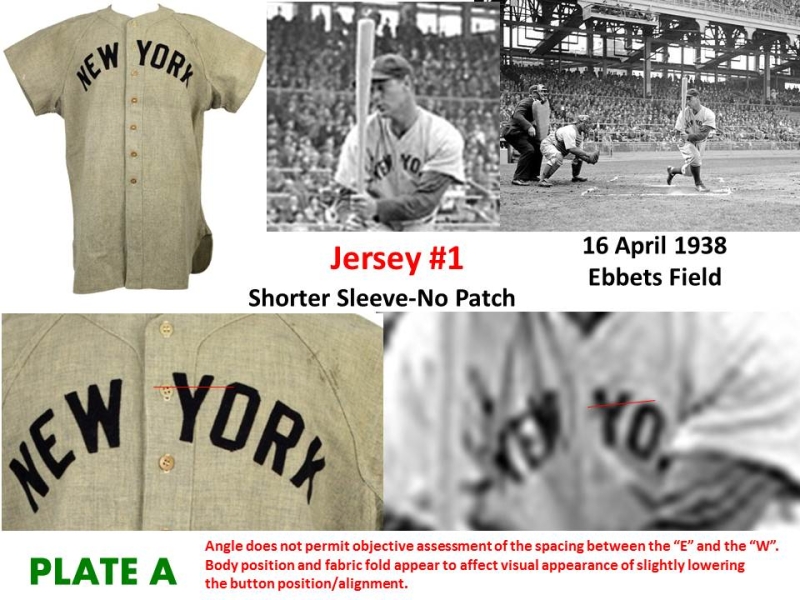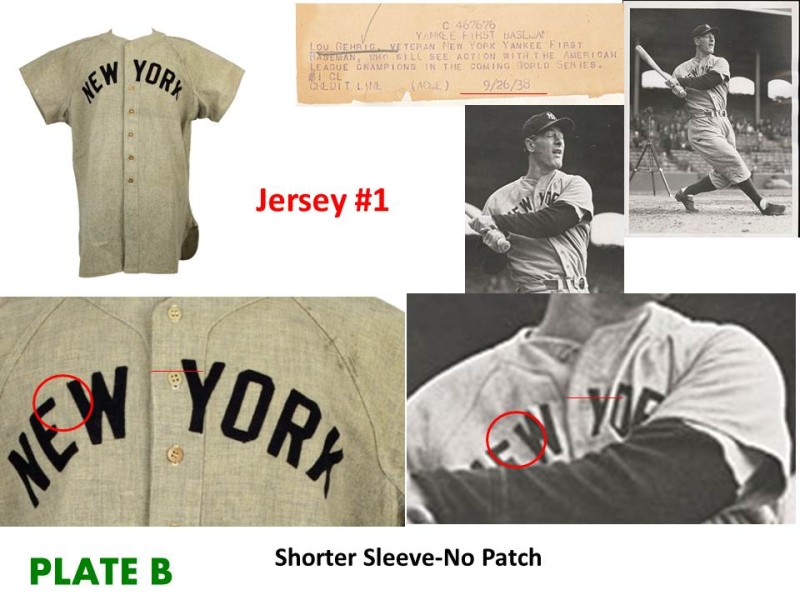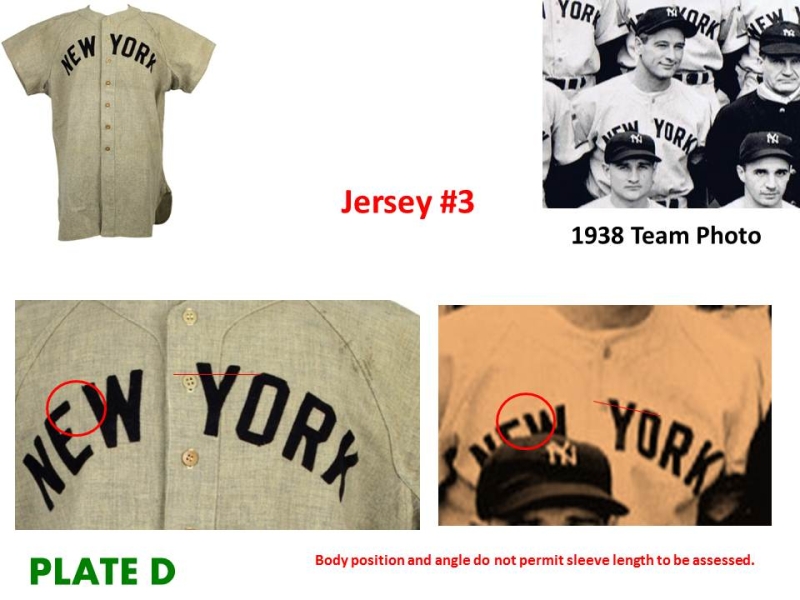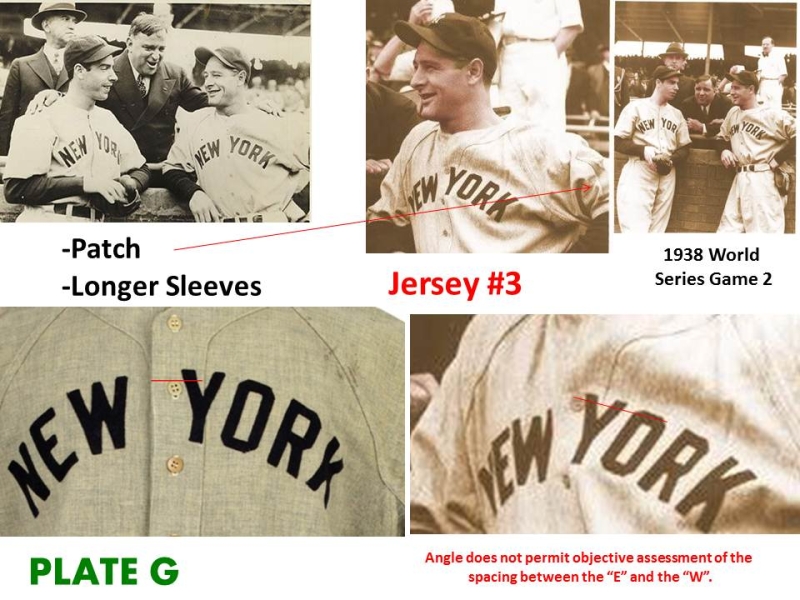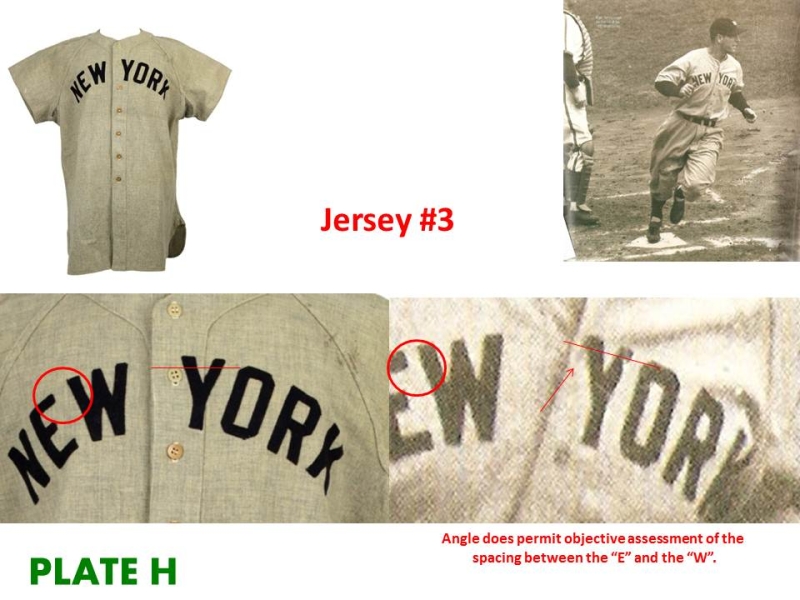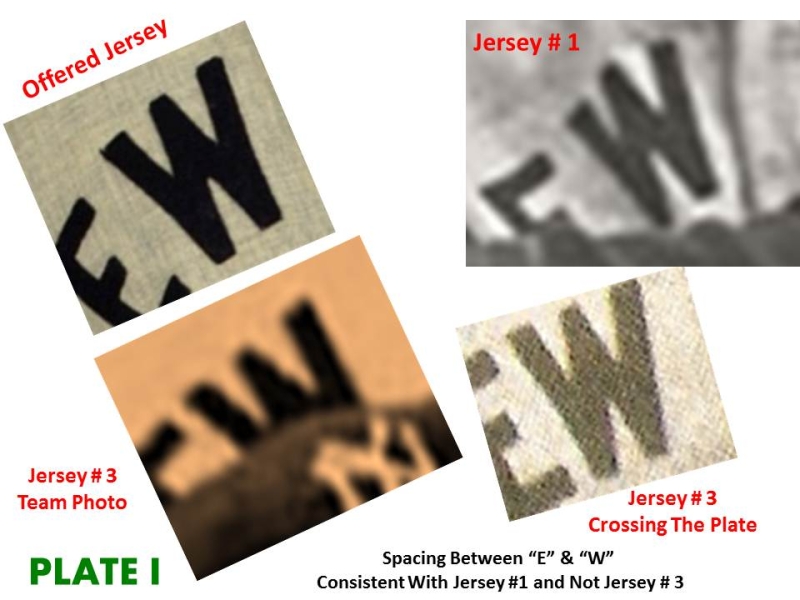1938 Lou Gehrig New York Yankees Road Jersey Imagery & Exclusionary Analysis of PLATES A-I
My previous related research efforts on Yankee uniforms from this time frame indicate that the likely annual population of uniforms potentially available for each player would in the range of 3-5. This is based on an ordering/inventory pattern of:
1-carried over from previous season
2-ordered for the season
1-2 for World Series
Notice I did not say 5 uniforms were ordered for each player each season. What I am saying is that you have to have some idea of how many uniforms are in play before you start playing around with your "photo matching". It has been my experience that most folks find something specific they are looking for and stop their research when they have convinced themselves they have found it. If this is your "photo matching process", then as a trained analyst, I have problems with this and I think you will see why in short order.
In looking at various images, I have identified what I feel are at least three (3) separate Lou Gehrig road jerseys from 1938. This is based off a combination of characteristics including:
-Sleeve length
-Font spacing
-Lettering alignment with the button line
-Presence of the World's Fair Patch
It is important to understand upfront that that sleeve length is only a distinctive characteristic under certain circumstances. Sleeve length can be changed or altered once a jersey has been produced; but the sleeve will only get shorter and not longer. In looking at the aspect of sleeve length and other characteristics over time, it is possible to use it as a way to distinguish one jersey from another, thus permitting the establishment of a known or likely population of jerseys for a particular player in a particular season. This becomes important since when you have a fairly well defined and accountable population of jerseys for a particular player in a particular year, claims of direct photographic attribution ("photo match") can enhanced or refuted by being able to identify, account for and exclude other possibilities. This is referred to as exclusionary analysis. The logic trail for the relationship between exclusionary and imagery analysis as it relates to direct photographic attribution ("photo matching") runs along these generic lines. By way of illustrative example, let's say that:
-Elmer Fudd likely had 3-5 jerseys available for wear throughout the entirety of the 1956 season based on what we know or believe about ordering/inventory patterns.
-Through imagery analysis, we have identified and accounted for at least 3 separate jerseys worn by Elmer Fudd in 1956.
-Imagery analysis has permitted us to exclude 2 of the 3 jersey worn by Fudd from being the one offered for consideration.
-The one remaining jersey is consistent with images available of Elmer Fudd from 1956.
-While the probability might be high that the offered jersey is the one Fudd is wearing in photographs from 1956, no definitive claim of direct photographic attribution is made because there are other possibilities that have not been accounted for an excluded.
I take the time to lay all of this out as a both an educational and cautionary message to this hobby/industry because before someone runs off and claims a "photo match", it is essential that they first identify what they know about the known or likely population and then physically demonstrate how these various jerseys have been identified and distinguished from one another, and then "excluded" from consideration. When this is not done, any claims of direct photographic attribution ("photo matching") are not objectively or statistically defendable.
What follows is a combination of imagery and exclusionary analysis as it relates to the 1938 Lou Gehrig New York Yankees road jersey being offered by Rob Lifson and Robert Edwards Auction (REA). I think it very important to note that this work includes analysis of images I did not have or had not seen at the time my original opinion was provided. The overwhelming majority were located and provided to me by Mr. Peter Nash and for that I am extremely grateful.
Jersey #1: This jersey is identified as being separate from Jersey #2 based on the lettering alignment with the button line. Jersey #1 also cannot be Jersey #3 because of the sleeve length. Although sleeves can be shortened, the images of Jersey #1 predate those of Jersey #3. The jerseys shown in PLATES A & B are considered the same jersey at this time as I can find no readily apparent disqualifiers. It should be noted that while PLATE B bears a date of 9/26/1938, this is not the date of the photograph. Rather it is date the image was provided for use with the caption and credits. I confirmed this by looking at the 1938 New York Yankees schedule for the period in question:
September 7-8: Boston
September 9-11: Washington
September 13: Cleveland
September 15-17: Detroit
September 18-19: St. Louis
September 20-22: Chicago
September 24-26: Home against Boston
In my opinion, it is not unreasonable to presume this image is from one of the previous road games (although it could be from any time prior to the 23rd of September as well). This jersey is also consistent with the image from April 16th of 1938, so I do not disqualify them from being the same jersey. You will also notice that this jersey does not feature the World Fair Patch worn by the New York Yankees, New York Giants, and Brooklyn Dodgers in 1938.
Jersey #2: This jersey is excluded from being the offered jersey based on the button alignment. Although this observable characteristic may appear to artificially vary in images based on angle of photograph and fabric folds/body position, the image angle and rather upright body position of Gehrig in the photograph in question seem to negate any appreciable impact those factors might have on this characteristic. Since Jersey #2 is neither Jersey #1 nor Jersey #3 based on sleeve length/lettering alignment, it will not be discussed further in any material manner. (PLATE C)
Jersey #3: Jersey #3 refers to those images that I either believe to be or can be shown to be from the 1938 World Series. I attribute the 1938 team photo to the World Series based on the fact that the Yankees are appearing in road uniforms and the 1938 World Series opened in Chicago. This would not be an uncommon event for a team to pose for such a picture. The composite details (both physical and those affected by angle of image) of the jersey identified as Jersey # 3 are such that I cannot exclude them from being the same jersey. Additional images of the team photo from different points of reference confirm that the sleeves Gehrig is wearing in this picture are elbow length, which is not consistent with Jersey #1 or Jersey #2. Longer sleeve length appears consistent with the other images that can be placed to the 1938 World Series. (PLATES D thru G)
In addition, and upon closer comparison, Jersey #3 is excluded from being the offered jersey based on the spacing between the letters "E" & "W" in NEW YORK. While the general alignment with the button line is consistent, it does appear to feature a spacing between the letters "E" & "W" in NEW YORK that is clearly less than one button width. This relies on the assumption that the jersey in the team photographs is the same one as the ones from the World Series.(PLATES H, I)
I also exclude Jersey #3 or any other jersey with long sleeves and the World's Fair Patch from being the same jersey as Jersey #1 or the offered jersey. The fabric cuts that I found on the offered jersey are in a location that would limit the application of that patch to have being placed on a jersey of longer sleeve length since the World's Fair Patch was sewn to the bottom of the sleeve.
Based on the fact that I have not been able to account for other possible jerseys, and then exclude them, I offer no definitive claim of photographic attribution that the offered jersey is the same as Jersey #1. What I feel this imagery analysis in the PLATES does show is that:
-Both the offered jersey and Jersey #1 share a common sleeve length.
-Sleeve length is a discriminator based on the chronology of the photographs.
-Both the offered jersey and Jersey #1 can be seen without the 1939 World's Fair Patch.
-Both the offered jersey and Jersey #1 share common and consistent font alignment with respect to the button line and consistent spacing between the letters "E" & "W."
What a combination of imagery and exclusionary analysis indicates to me is that the offered jersey could be Jersey #1. In addition, since we now have images of Gehrig wearing a jersey without the World's Fair Patch, it is quite conceivable that no patch was ever applied to the jersey and that the location of the fabric cuts is a coincidence. This would not have any appreciable impact on my overall opinion of the jersey and would only affect the overall grade assigned MEARS by +.5 since the A9 opinion provided by Dave Bushing did not deduct points for this. In my opinion (A5), I deducted -1 for the patch. Thus a revised grade of A6 from me would leave the aggregate grade at A7.5 (average A6 & A9) as opposed to A7.
This article has been about two separate but related issues; process and product. My hope is that the hobby/industry now has a better understanding of the essential relationship between imagery and exclusionary analysis when it comes to supporting a position of direct photographic attribution ("photo matching"). When the collecting community or auction houses conduct or subsidize substandard work, process, and analysis, then we should not be surprised when it results in "photo match" claims that are not objectively or statistically defendable. Please know for my work in this area, I leverage no special tools or technology. If you are looking at the images on a computer screen and care to invest about $1.00 in a clear ruler you can lay on the screen, then you are armed with the same tools as me. This only leaves differences in experience, training, and process.
This article has also been about a product or the ability for the collector to see and know as much as possible about a particular jersey. In the case of this 1938 Lou Gehrig New York Yankees Road Jersey, I maintain my original position that "based on my physical examination of this jersey and supporting data, it is my opinion that this jersey posses all of the characteristics you would expect to find in a 1938 New York Yankees road uniform supplied by Spalding for use and wear by Lou Gehrig during this period".
This is an opinion based on:
-Imagery analysis.
-Comparative trend analysis with other Lou Gehrig and period New York Yankee jerseys I have examined.
-Comparative fabric analysis with other period and year specific Spalding major league grade/quality uniform products.
-Exclusionary analysis to determine a likely population and offering data to support either the possibility of exclusion or inclusion with respect to the issue of direct photographic attribution.
-A physical examination of the jersey utilizing UV lighting, a light table, illuminated magnification, and the use of a digital microscope.
I also maintain my previous position of that "if you are serious buyer then take this jersey very seriously. Although there are some condition issues, it is one of only a handful of legitimate Lou Gehrig jerseys out there and the likely population of good Gehrig jerseys can only to get smaller. This population has been cut down significantly as I have evaluated three others that were found to be problematic for any number of reasons. If you are in the market, then buy the jersey for what it is based on what you can objectively see and know. I think you'll be thrilled and lucky to have it as the display appeal is incredible and the conservation work in the sleeves is museum quality".
As always, collect what you enjoy and enjoy what you collect.

